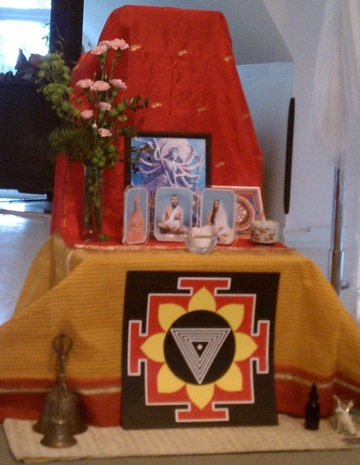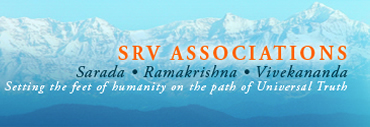Student Notebook
Article Index
Susan's Reflection
 "The Seattle retreat was wonderful in every way! Mantra, Tantra and Yantra were explained in wonderful detail with Babaji's inimitable style accompanied by his usual array of AMAZING charts to facilitate deeper understanding.
"The Seattle retreat was wonderful in every way! Mantra, Tantra and Yantra were explained in wonderful detail with Babaji's inimitable style accompanied by his usual array of AMAZING charts to facilitate deeper understanding.
The location was charming and everything was well organized, comfortable, and divine, along with wonderful, erudite and sweet spiritual companions/seekers, good food and lots of cozy places to relax and further study and ponder all the deep, thought provoking teaching and transmissions given by Babaji on this most lovely of retreats. Many thanks!"
Student Notebook:
Tantra Mantra & Yantra
Held in Seattle – March of Spring, 2011 [Babaji launched this Tantra retreat with a devotional song to the Divine Mother: "Devi Duhkha Harini Tarini," a song in praise of the Mother who saves Her spiritual children from suffering. The word Tantra itself means "that which saves." Mother saves us through right knowledge, wisdom, devotion and the will to do spiritual practices -- all of which are embodied in the sacred scriptures and the darshanas that stream from them. The song further states that Mother is the Purveyor of the Agamas and the Nigamas, meaning that She is the Wisdom and its transmission in both the Tantric and Vedic paths. This was a poignant beginning to our retreat.
[Babaji launched this Tantra retreat with a devotional song to the Divine Mother: "Devi Duhkha Harini Tarini," a song in praise of the Mother who saves Her spiritual children from suffering. The word Tantra itself means "that which saves." Mother saves us through right knowledge, wisdom, devotion and the will to do spiritual practices -- all of which are embodied in the sacred scriptures and the darshanas that stream from them. The song further states that Mother is the Purveyor of the Agamas and the Nigamas, meaning that She is the Wisdom and its transmission in both the Tantric and Vedic paths. This was a poignant beginning to our retreat.
Babaji began with an orientation on salient points of the Vedic perspective followed by the more Tantric perspective. These two paths have been running side by side for millennia and therefore also share some things in common. For both Nigama and Agama the goal is nondual Realization. The following are some notes from a student's notebook. They are not intended to represent the entire retreat, but the more coherent portions of said notebook.]
Nigama (Vedic scriptures)
The Nature of Brahman is Consciousness. In the Svetashvataro Upanisad, It is described as "Deva-atma-shaktim,” the Energy/Self/God at the core of our awareness that is all one thing (nikhilani). By seeing these three as such, the mind will be purified and our intellectual limits will be dissolved. Further, by thinking in this manner, we skirt the rather useless issue of "does God exist?"
The Nigamas say to penetrate through false superimposition (vivarta) and destroy root ignorance. This can be done by grace or self-effort, which at their roots are really the same. One raises oneself by the power of the Self unto the Great Self. This effort to pierce through all that is false (viveka) keeps one from the tendency towards superficiality.
[The following is an especially significant teaching because it determines the way people regard knowledge. Is Knowledge something that is generated, or is it something that eternally exists? As one ponders this, the way opens to understand the Vedic teaching of AUM as the uncaused primal Vibration, as well as the Tantric teaching of Sristhi Rahasya, the secret of Creation (coming later in these notes), and how all phenomena and the Consciousness that perceives them, are without origin and without separation.]
There are four points of view regarding the source of the scriptures, from basic to superior:
1. Paurusheya - The scriptures are the product of the finest human intellect.
2. Arya - Knowledge comes from God through the minds of sages and seers.
3. Ishvariya - Knowledge comes from the Trinity and is continually emanating from Them.
4. Apaurusheya - Vedas and scriptures are of Divine Origin. They are eternal. This is also called Shabda.
The Vedas have four characteristics:
1. Synthesis of earthly and spiritual: They teach a synthesis between the empirical and the spiritual. In this way they may have been influenced by the Tantric view. The Vedas are all about integration and harmony. The ancient Vaidikas put forth two goals for society: abhyudaya and nihsreyasa, the material welfare of all and the highest good of all (Self-realization). But spiritual aspiration had to be the foundation of worldly attainments.
2. Universality: The final conclusion in the Vedas is that "All is Brahman."
3. A harmonious sense of social values combined with a liberal view.
4. Impartiality: Everything is viewed from a detached, impartial standpoint, as opposed to dogmatic standards of right and wrong.
Now the Agamas, Tantras, for Contrast
[It should be noted that there are Tantra scriptures for five different Ideals: Shakti (Divine Mother), Vishnu, Siva, Ganapati, and Surya (Sun God). Our retreat drew primarily on the Shakta and Shaivite perspectives.]
The Tantras are concerned with revelation and direct perception. Tantra does not speak so much in terms of ignorance, but focuses more on everything being a manifestation of Consciousness in the mode of the play of Siva and Shakti. The imperfections (malas) of living beings are "assumed" by each individual. When these malas (imperfections) ripen, they get filled with Siva and Shakti. In other words, imperfection, being in the nature of relativity and the mind, is taken on but looked upon as a veil which will simply evaporate over time, bringing one closer to Paramasiva naturally.
[Babaji presented the chart, "Sristhi Rahasya, Tantra's Secret of Creation," generally constructed from the Kashmiri Shaivism perspective in Tantra. In this chart, Niskala Siva, or Paramasiva, is Ultimate Reality, transcendent of everything. Chid-Jyoti is the ocean of Consciousness emanating from Paramasiva. Its first expression is Sakala Siva (Essence of Wisdom) and Mahashakti (Divine Will & Power) known as "the Two who are One." In brief, the primordial, inherent Love and Attraction of Sakala Siva and Mahashakti brings forth the subtle Bindu, wherein all the cosmic principles like time, space, cosmic laws, etc., are held in potential. This is the source of all triputis (time, space, causation; past, present, future; projection, preservation, dissolution). After the Bindu bursts in Love, the conditions are set for Shabda Brahman, the primal vibration from whence creation begins. From Shabda Brahman (Omkara) come the tanmatras (subtle elements) that bring forth the gross elements of ether, air, fire, water, and earth.]
Characteristics of the Agamas
1. Tantra views the individual as always one with Universal Reality. A subtle awakening process that ultimately unites the Supreme Soul and the individual Soul is guaranteed. It is only measured by how soon the practitioner wants to "eat." Holy Mother, Sri Sarada Devi, gave the analogy that everyone will eat but the most industrious will cook their meal early in the day, while others, less industrious, may have to wait until midnight. So those with intense yearning for freedom will attain this union sooner.
2. Tantra looks at the individual in terms of microcosm and the macrocosm, however, everything revolves around mankind. Human beings have physical, mental, and spiritual sides that must be developed.
3. Tantra prefers the Abhasavada [that the individual is a thought projection from the fourfold mind] view instead of the Avaccheda view of false superimposition. Tattvas (cosmic principles) are analyzed from the subjective and objective perspectives as well as from the individual and macrocosmic perspectives.
[Other points Babaji made while introducing Tantra:]
Paramasiva, Ultimate Reality, Immutable and All-pervasive, is characterized by the statement: "Consciousness Is." Siva's Shakti has six grades of Consciousness:
Chit - Existence
Ananda - Experience
Iccha - Will
Jnana - Knowledge
Kriya - Dynamism
Dravya - Production
Consciousness & Knowledge
The worshippers of the Divine Mother propose a path of nondualism termed Shakta-advaita-vada. Shaktadvaitavada leans toward qualified nondualism in that it is a philosophical perspective founded on the experience of Reality as pure Consciousness. Its primary directive is to manifest the Soul's inherent perfection (Siddhi). Its secondary directive is to free the soul from cycles of rebirth (Karmabandha), and its result is the awakening of the Kundalini to reveal Atman via Pure mind (Chit shuddhi).
Regarding this twin directive and its accomplishment, for individuals in the world there are two possibilities or tendencies – souls that dissolve into Brahman and reform their minds later, versus those who dissolve their minds into the world. It is nearly impossible to extract the mind from body, matter, and senses. That the luminaries can do this is nothing short of miraculous, but most beings either skirt spirituality altogether, or simply give in to the world. Once this occurs, it is like scattering mustard seeds in the wind, meaning that the mind's thoughts are extremely difficult to gather back and focus upon Reality.
The Two Truths of Supreme Knowledge, Pratibha:
Pratibha is the Inherent Nature or Knowledge in each person. With regard to Origins, this Knowledge is Self-Revelatory. It is not sense born. It is also called Parasamvit, Chitshakti, and Prajna. The nature of this Knowledge is Divine Dynamism and is considered feminine, the Divine Mother. It is called by various names expressing different aspects of its nature:
Guru Tattva - The inner guiding principle. All are born with this. It is Self-revelatory.
Trikalatita - This Knowledge is beyond time. It did not evolve over time. It is eternal.
Nirmama - This Knowledge is transcendent of "I," "me," and "mine." It is not personalized knowledge like that which the intellect claims for its own.
[Other teachings, intended to clarify correlations and distinctions between Advaita Vedanta and Tantra, were given]:
- The basis of Advaita Vedanta is "All is Brahman."
- The basis of Tantra is Siva & Shakti, the Two who are One.
- The method of Advaita Vedanta is viveka, discrimination between the Real and the unreal, the Eternal and the noneternal.
- The method used in Tantra is Tattvavichara, analysis of cosmic principles from the standpoint that everything is a manifestation of Siva and Shakti.
- Purification of body and mind is achieved in Advaita Vedanta via Tattvajnan and Upasana. Tattvajnan refers to the concentrated inspection of Wisdom principles culminating in knowledge of the Supreme principle, Brahman. Upasana is worshipful meditation.
- Purification of body and mind is achieved in Tantra via Bhuta shuddhi and Chit shuddhi, observation of the rules of purity with regard to places, objects, actions, and mind.
- The conclusion, Siddhanta, to be reached via direct experience in Advaita Vedanta is non-origination: Ajati.
- In Tantra, the basis, method, and purifications make one fit to understand non-origination.
Question: What is the distinction between Viveka and Tattvavichara?
Babaji: Viveka, discrimination, cuts to the chase. It discards the noneternal, the insentient, the unreal. Tattvavichara, however, is the study of principles in terms of their dualities, so that when/if one is faced with dualities one will recognize them. In Vedanta, all name and form, all dualities, are ultimately illusory. In Tantra, it is more to the point that it is all useful, even the negativities.
A mantra or mahavakya in Tantra is, Prabhuddha sarvata tishtet - "Get yourself awakened for all time!"
Still, one's consciousness may be awakened (prakasha) and free (vimarsha), but even this is still "achit" until full awakening comes.
Teachings on Siva Siva is looked upon in terms of indeterminate (Niskala, beyond time), and determinate (Sakala, with time). Both are hard to understand because Niskala is formless and Sakala is so vast.
Siva is looked upon in terms of indeterminate (Niskala, beyond time), and determinate (Sakala, with time). Both are hard to understand because Niskala is formless and Sakala is so vast.
For greater comprehension, then, Siva becomes a "family man." He can be viewed not only in terms of the monastic aspect, or as the great renunciate seated in Samadhi at the top of Mt. Kailash, but also as Kula, a prime member of the family tradition. In this regard, and to bring enlightenment to the dharmic masses, Siva grants the sadhana scriptures that speak in terms of teachings on the Word/japa, dhyan, bhava, and Brahma sadhana (storming the gates), and other clarifications.
Siva has five functions:
1. Sristi - projection of the worlds
2. Stithi - preservation of the worlds
3. Samhara - dissolution of the worlds
4. Tirodhana - Self-limitation [worlds, objects, and beings are like masks Siva puts on]
5. Anugraha - Grace, expression
Siva has four padas, or works:
1. Jnana - providing philosophical systems
2. Kriya - encouraging people to carry sadhana into practice in terms of the philosophy
3. Yoga - spiritual practices/disciplines
4. Charya - spreading the teachings
Aham ("I") includes everything from the gross ego to Brahman. It is a name for Siva. It is called Purnahanta, the nondual "I" in fullness, in Its unbounded freedom. And what am I as Siva? Aham is to be meditated upon thusly in its three matras:
"A" is Para-akasha, the supreme space of Pure Being
"HA" is Svatantriya, inherent freedom
"M" is the Bindu, the point of first emanation
Ground everything in nonseparation in order to ensure freedom to explore Shakti's manifestations. The Secret of Creation is nonseparation.
While one is under the spell of maya, one considers the dualities to be real. But vivekajnan, discriminative knowledge, enables one to distinguish between Chit and achit, what is Sentient and what is insentient. Development of this ends the rounds of birth and death in ignorance.
Mantra, Meaning, & Practice
[A significant portion of the retreat was given to the meaning, potential, and practice of Mantra. A few notes are gathered from those sections:]
 A quote from one of Babaji's charts states, "All the alphabets and their corresponding fractions, and the mantras comprised of them, are all intrinsically connected with the Self. Due to the influence of nescience, the maya-shakti covers their true meaning and function, and the eternal Self takes on a sense of individuality and assumes atomic proportions. Recitation of the mantra awakens the power inherent in the Word and restores meaning, thus wisdom."
A quote from one of Babaji's charts states, "All the alphabets and their corresponding fractions, and the mantras comprised of them, are all intrinsically connected with the Self. Due to the influence of nescience, the maya-shakti covers their true meaning and function, and the eternal Self takes on a sense of individuality and assumes atomic proportions. Recitation of the mantra awakens the power inherent in the Word and restores meaning, thus wisdom."
Prana is your vehicle and mantra is the fuel in attaining Self-realization. Devotional songs and hymns, scriptures, mantras, the mahavakyas - these are all connected. Mantra will help one inspect the world; it will focus the mind. Vitalization of the mantra requires connecting it with tattvajnan. One must animate and charge up the chitta (thoughts of the mind). In Kundalini Yoga, this is spoken of as bringing up the prana. Do not animate the chitta with mundane objects, as these are hard to detach from later. Instead, vibrate with the teachings and concentrate on the Ishtam, the Lord/Mother. Later these can be dissolved easily into the Antaryami (inner ruler seated in the heart), and into Om. Why are these easy to dissolve? Because at the point one is able to concentrate fully on subtle knowledge and the Ishtam, one is already intuiting Om. Thoughts easily fall by the wayside and awareness intensifies, infused with the presence of Om. One's Awareness comes forward because the vibrating mind is not in the way anymore.
The human mind has trouble comprehending even 100 or 200 years of time, partly because we do not believe in our own perpetuity - that we have lived before. "Creation, preservation, and destruction" is clumsy compared to "projection, sustanence, and withdrawal." In the latter view, even a 1000 years is nothing. The way to understand this is via your three states of consciousness: waking, dream, and deep sleep. In their earliest inspection of Consciousness in all its modes, the rishis realized that we turn the world on and off by the mind's power of projection.

